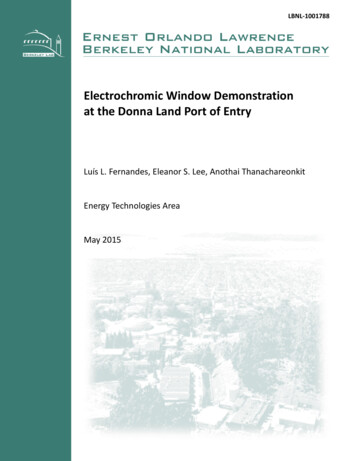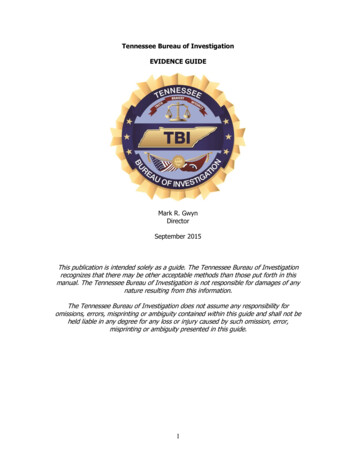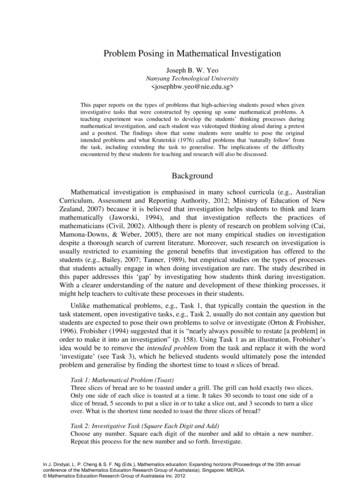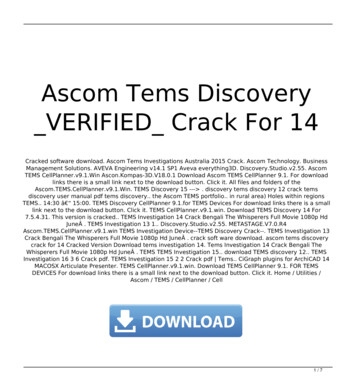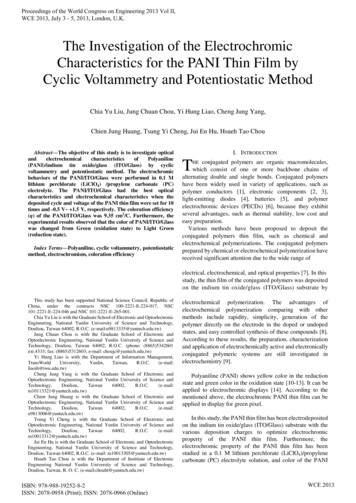
Transcription
Proceedings of the World Congress on Engineering 2013 Vol II,WCE 2013, July 3 - 5, 2013, London, U.K.The Investigation of the ElectrochromicCharacteristics for the PANI Thin Film byCyclic Voltammetry and Potentiostatic MethodChia Yu Liu, Jung Chuan Chou, Yi Hung Liao, Cheng Jung Yang,Chien Jung Huang, Tsung Yi Cheng, Jui En Hu, Hsueh Tao Chou Abstract—The objective of this study is to investigate ine(PANI)/indium tin oxide/glass (ITO/Glass) by cyclicvoltammetry and potentiostatic method. The electrochromicbehaviors of the PANI/ITO/Glass were performed in 0.1 Mlithium perchlorate (LiClO4) /propylene carbonate (PC)electrolyte. The PANI/ITO/Glass had the best opticalcharacteristics and electrochemical characteristics when thedeposited cycle and voltage of the PANI thin film were set for 10times and -0.5 V 1.5 V, respectively. The coloration efficiency(η) of the PANI/ITO/Glass was 9.35 cm2/C. Furthermore, theexperimental results observed that the color of PANI/ITO/Glasswas changed from Green (oxidation state) to Light Green(reduction state).Index Terms—Polyaniline, cyclic voltammetry, potentiostaticmethod, electrochromism, coloration efficiencyI. INTRODUCTIONTconjugated polymers are organic macromolecules,which consist of one or more backbone chains ofalternating double and single bonds. Conjugated polymershave been widely used in variety of applications, such aspolymer conductors [1], electronic components [2, 3],light-emitting diodes [4], batteries [5], and polymerelectrochromic devices (PECDs) [6], because they exhibitseveral advantages, such as thermal stability, low cost andeasy preparation.Various methods have been proposed to deposit theconjugated polymers thin film, such as chemical andelectrochemical polymerizations. The conjugated polymersprepared by chemical or electrochemical polymerization havereceived significant attention due to the wide range ofHEelectrical, electrochemical, and optical properties [7]. In thisstudy, the thin film of the conjugated polymers was depositedon the indium tin oxide/glass (ITO/Glass) substrate byThis study has been supported National Science Council, Republic ofChina, under the contracts NSC 100-2221-E-224-017, NSC101-2221-E-224-046 and NSC 101-2221-E-265-001.Chia Yu Liu is with the Graduate School of Electronic and OptoelectronicEngineering, National Yunlin University of Science and Technology,Douliou, Taiwan 64002, R.O.C. (e-mail:u9813335@yuntech.edu.tw)Jung Chuan Chou is with the Graduate School of Electronic andOptoelectronic Engineering, National Yunlin University of Science andTechnology, Douliou, Taiwan 64002, R.O.C. (phone: (8865)5342601ext.4333; fax: (8865)5312603; e-mail: choujc@yuntech.edu.tw)Yi Hung Liao is with the Department of Information C.(e-mail:liaoih@twu.edu.tw)Cheng Jung Yang is with the Graduate School of Electronic andOptoelectronic Engineering, National Yunlin University of Science 0113321@yuntech.edu.tw)Chien Jung Huang is with the Graduate School of Electronic andOptoelectronic Engineering, National Yunlin University of Science 813006@yuntech.edu.tw)Tsung Yi Cheng is with the Graduate School of Electronic andOptoelectronic Engineering, National Yunlin University of Science 0013312@yuntech.edu.tw)Jui En Hu is with the Graduate School of Electronic and OptoelectronicEngineering, National Yunlin University of Science and Technology,Douliou, Taiwan 64002, R.O.C. (e-mail: m10013305@yuntech.edu.tw)Hsueh Tao Chou is with the Department of Institiute of ElectronicEngineering National Yunlin University of Science and Technology,Douliou, Taiwan, R. O. C. (e-mail:chouht@yuntech.edu.tw)ISBN: 978-988-19252-8-2ISSN: 2078-0958 (Print); ISSN: 2078-0966 (Online)electrochemical polymerization. The advantages ofelectrochemical polymerization comparing with othermethods include rapidity, simplicity, generation of thepolymer directly on the electrode in the doped or undopedstates, and easy controlled synthesis of these compounds [8].According to these results, the preparation, characterizationand application of electrochemically active and electronicallyconjugated polymeric systems are still investigated inelectrochemistry [9].Polyaniline (PANI) shows yellow color in the reductionstate and green color in the oxidation state [10-13]. It can beapplied to electrochromic displays [14]. According to thementioned above, the electrochromic PANI thin film can beapplied in display for green pixel.In this study, the PANI thin film has been electrodepositedon the indium tin oxide/glass (ITO/Glass) substrate with thevarious deposition charges to optimize electrochromicproperty of the PANI thin film. Furthermore, theelectrochromic property of the PANI thin film has beenstudied in a 0.1 M lithium perchlorate (LiClO4)/propylenecarbonate (PC) electrolyte solution, and color of the PANIWCE 2013
Proceedings of the World Congress on Engineering 2013 Vol II,WCE 2013, July 3 - 5, 2013, London, U.K.II. EXPERIMENTALA. MaterialsIndium tin oxide/glass (ITO/Glass) substrate wasmanufactured by Sinonar Corp., Taiwan, and its sheetresistivity is 7 Ω/ . Aniline (ANI) solution, hydrogen chloride,(HCl) solution, lithium perchlorate (LiClO4) powders andpropylene carbonate (PC) solution were all purchased fromAcros Organics Corp., USA.B. InstrumentationBioLogic potentiostat/Galvanostat (model SP-150,France) was used to electrodeposit the PANI thin film on theITO/Glass and to perform cyclic voltammetry (CV)measurements, respectively. OTO Photonic Spectrometer(model SD1200-LS-HA, Taiwan) was used to measuretransmittance of electrochromic thin film.C. Preparation of the PANI Thin FilmIn this study, the electrochromic PANI thin film have beendeposited on the indium tin oxide/glass (ITO/Glass) substrateby cyclic voltammetry and potentiostatic method. The PANIthin film was deposited on the ITO/Glass by cyclicvoltammetry in 1 M ANI and 2 M HCl with deionized (D. I.)water, and the potentials were set at -0.5 V 1.5 V, the scanrate is 100 mV s-1. The deposited times were controlled for 10,20, 30, 40, 50 and 60 times, respectively. On the other hand,the PANI thin film was deposited on the ITO/Glass bypotentiostatic polymerization in 1 M ANI and 2 M HCl withdeionized (D. I.) water, and the potential was set at 1.5 V.The deposited time were controlled for 400, 800, 1200, 1600,2000 and 2400 s, respectively. The PANI thin film electrodeswere removed from the monomer/electrolyte solution afterelectrochemical polymerization and rinsed with 0.1 M HCl toproduce cleaned surface without monomer. Fig. 1 was theschematic diagram of the electrochromic PANI device in thisstudy.III. RESULTS AND DISCUSSIONThe PANI thin film was obtained by cyclic voltammetryand potentiostatic method. And the PANI thin film wasobtained by electrochemical polymerization at potentialslightly higher than the monomer oxidation onset potential,and obtained a homogeneous thin film on the ITO/Glass. Theredox behavior of the ANI monomer was obtained in 1 MANI and 2 M HCl with D. I. water by cyclic voltammetry, asshown in Fig. 2. An oxidation onset potential was obtainedabout 1.25 V. Because lower potential could not synthesizethe ANI, the potential of polymerization of the PANI thin filmwas set at 1.5 V. The CV curves of the PANI thin filmexhibited that the onset potential of oxidation of ANI was at 1.25 V in 1 M ANI and 2 M HCl with D. I. water, as well as,the oxidation peak of the PANI thin film at 0.75 V andreduction peak of the PANI thin film was at 0.15 V duringthe 20 cycles.1086420-2-4-6-8Current Density (mA/cm2)thin film was switched between green (1.0 V (PANI vs.Platinum (Pt))) and yellow (-0.5 V (PANI vs. Pt)).20th1st1st20th-0.50.00.51.0E (V) vs. Ag/AgCl1.5Fig. 2. Cyclic voltammograms of PANI thin film during electrodeposition(scan rate 100 mV/s).As shown in Fig. 3, the cyclic voltammetry of thePANI/ITO/Glass and the maximum current density wasobserved when the PANI thin film (the PANI/ITO/Glass with10 times) was fabricated by cyclic voltammetry. During the-oxidation (anodic peak at 0.75 V), the ClO4 ions ofLiClO4/PC electrolyte solution were injected from the PANIthin film. During the reduction (cathodic peak at -0.25 V),-the ClO4 ions of LiClO4/PC electrolyte solution wereexcluded the PANI thin film. The overall reaction, involvingion diffusion -in and -out of the polymer matrix to balance thecharge, can be represented as in Eq. (1) for PANI [13],- --(ANI)n ny(ClO4 ) [(ANI ) y(ClO4 )]n nye(1)(Light Green)(Green)Where n is the number of repeated units and y is thestoichiometric number of the counter ion [13].Fig. 1. Structure of electrochromic PANI device [15].ISBN: 978-988-19252-8-2ISSN: 2078-0958 (Print); ISSN: 2078-0966 (Online)WCE 2013
543210-1-2-3-4-1.0Deposited 400 s by Potentiostatic MethodDeposited 10 Times by Cyclic Voltammetry-0.5Transmittance (%)Current Density (mA/cm2)Proceedings of the World Congress on Engineering 2013 Vol II,WCE 2013, July 3 - 5, 2013, London, U.K.0.00.51.0E (V) vs. Ag/AgCl1.5Fig. 3. Cyclic voltammograms of the PANI/ITO/Glass in 0.1 M LiClO4/PCelectrolyte solution with scan rate of 100 mV s-1 by differentmethods: -Deposited 400 s by constant potential 1.5 V; -Deposited 10 times by deposited voltage -0.5 V 1.5 V.Deposited 10 cycles -0.5 VDeposited 10 cycles 1.0 V400450500 550 600 650Wavelength (nm)700Fig. 4. Transmittances of the PANI/ITO/Glass (the PANI/ITO/Glass with 10times) was immersed in 0.1 M LiClO4/PC electrolyte solution, and theoxidizing potential and reducing potential were set 1.0 V and -0.5 V,respectively.As shown in Fig. 5, the colored and bleachedtransmittances of the PANI/ITO/Glass were studied with 400second and 1.5 V by potentiostatic method. ThePANI/ITO/Glass was performed in 0.1 M LiClO4 /PCelectrolyte solution. The potentials were -0.5 V and 1.0 V.The solid shape and hollow shape were coloring andbleaching, respectively. The PANI/ITO/Glass has themaximum optical transmittance variation (ΔT(%)) which was1 % at 550 nm.ISBN: 978-988-19252-8-2ISSN: 2078-0958 (Print); ISSN: 2078-0966 (Online)500 550 600 650Wavelength (nm)700As shown in Fig. 6, the coloration efficiency (η) of thePANI/ITO/Glass with different fabricated parameters. ThePANI/ITO/Glass had the best transmittance variation (20 %)when the deposited cycle and voltage of the PANI thin filmwere set for 10 times and -0.5 V 1.5 V, respectively. Thecoloration efficiency of the PANI/ITO/Glass was 9.35 cm2/C.Compared with the above results, the coloration efficiency ofthe PANI/ITO/Glass was higher than other literatures [16-18] ,as summarized in TABLE I.3010Deposited Cycle (times)20304050 T(%) of Cyclic Voltammetry of Cyclic Voltammetry T(%) of Potentiostatic Method of Potentiostatic Method60Wavelength at 550 nm2010080601040200400400450Fig. 5. Transmittances of the PANI/ITO/Glass (the PANI/ITO/Glass with 400second) was immersed in 0.1 M LiClO4/PC electrolyte solution, andthe oxidizing potential and reducing potential were set 1.0 V and-0.5 V, respectively.Coloration Efficiency (cm2/C)1009080706050403020100Deposited 400 second -0.5 VDeposited 400 second 1.0 V800 1200 1600 2000 2400Deposited time (second)Transmittance Variation (%)Transmittance (%)As shown in Fig. 4, the colored and bleachedtransmittances of the PANI/ITO/Glass were studied with 10times and -0.5 V 1.5 V by cyclic voltammetry. ThePANI/ITO/Glass was performed in 0.1 M LiClO4 /PCelectrolyte solution. The potentials were -0.5 V and 1.0 V.The solid shape and hollow shape were coloring andbleaching, respectively. The PANI/ITO/Glass has themaximum optical transmittance variation (ΔT(%)) which was20 % at 550 nm.10090807060504030201000Fig. 6. Transmittance variation and coloration efficiency of thePANI/ITO/Glass in 0.1 M LiClO4/PC electrolyte solutionbetween oxidizing potential ( 1.0 V) and reducing potential(-0.5 V).The variational colors of the electrochromic thin filmwere observed by the chromaticity coordinates of thecommission internationale de l’Eclairage 1931 (CIE 1931).Fig. 7 shows the chromaticity coordinates of CIE ofPANI/ITO/Glass (the colored and bleached transmittances ofthe PANI/ITO/Glass were studied with 10 times and -0.5 V 1.5 V by cyclic voltammetry) were performed in 0.1 MLiClO4 /PC electrolyte solution. The PANI/ITO/Glass inyellow color state (reduction state) was at -0.5 V (PANI vs.Pt), and the chromaticity coordinate of the PANI/ITO/Glasswas (0.28, 0.48). Green color state (oxidation state) of PANIthin film was at 1.0 V (PANI vs. Pt), and the chromaticitycoordinate of the PANI/ITO/ Glass was (0.14, 0.54).WCE 2013
Proceedings of the World Congress on Engineering 2013 Vol II,WCE 2013, July 3 - 5, 2013, London, U.K.TABLE I. COMPARISON OF THE COLORATION EFFICIENCY OF THE PANI/ITO/GLASS IN THIS STUDY AND PREVIOUS LITERATURESFOR ELECTROCHROMIC (%))Time ofManufactureCost 555020shortlowIn this 9)[17](2009)[17](2009)[18](2009)N/A: Not ApplicableGreenGreen( 1.0 V)( 1.0 V)(-0.5 V)(-0.5 V)RedBlueFig. 7. Chromaticity coordinates of CIE of PANI/ITO/Glass (the colored andbleached transmittances of the PANI/ITO/Glass were studied with 10times and -0.5 V 1.5 V by cyclic voltammetry) were performed in0.1 M LiClO4 /PC electrolyte solution.Fig. 8 shows the chromaticity coordinates of CIE ofPMeT/ITO/Glass (the PANI/ITO/Glass were studied with400 second and 1.5 V by potentiostatic method) wasperformed in 0.1 M LiClO4 /PC electrolyte solution. ThePANI /ITO/Glass in light green color state (reduction state)was at -0.5 V (PANI vs. Pt), and the chromaticity coordinateof the PANI/ITO/Glass was (0.16, 0.42). When dark greencolor state (oxidation state) of PANI thin film was at 1.0 V(PANI vs. Pt), and the chromaticity coordinate of thePANI/ITO/ Glass was (0.04, 0.44).ISBN: 978-988-19252-8-2ISSN: 2078-0958 (Print); ISSN: 2078-0966 (Online)RedBlueFig.8.Chromaticity coordinates of CIE of PANI/ITO/Glass (thePANI/ITO/Glass were studied with 400 second and 1.5 V bypotentiostatic method) were performed in 0.1 M LiClO4 /PCelectrolyte solution.IV. CONCLUSIONSThe electrochromic PANI thin film has been successfullydeposited on ITO/Glass by cyclic voltammetry andpotentiostatic method. The PANI/ITO/Glass had the besttransmittance variation (20 %) when the deposited cycle andvoltages of the PANI thin film were set for 10 times and-0.5 V 1.5 V, respectively. The coloration efficiency of thePANI/ITO/Glass was 9.35 cm2/C. According to theexperimental results, the electrochromic PANI thin film wasprepared by cyclic voltammetry, which has the besttransmittance variation and current density. Furthermore, theexperimental results obtained the colors of thePANI/ITO/Glass were from Green (oxidation state) to LightGreen (reduction state). According to the above results, theelectrochromic PANI/ITO/Glass can be applied in display forgreen pixel.WCE 2013
Proceedings of the World Congress on Engineering 2013 Vol II,WCE 2013, July 3 - 5, 2013, London, U.K.REFERENCES[1] X. Crispin, F. L. E. Jakobsson, A. Crispin, P. C. M. Grim, P.Andersson, A. Volodin, C. van Haesendonck, M. Van der Auweraer,W. R. Salaneck, M. Berggren, “The origin of the high conductivity lfonate)(PEDOT-PSS) plastic electrodes,” Chem. Mater., vol. 18, pp. 4354-4360, 2006.[2] H. Sirringhaus, T. Kawase, R. H. Friend, T. Shimoda, M. Inbasekaran,W. Wu, E. P. Woo, “High-resolution inkjet printing of all-polymertransistor circuits,” Sci., vol. 290, pp.2123-2126, 2000.[3] H. E. Katz, J. Huang, “Thin-film organic electronic devices,” Annu.Rev. Mater. Res., vol. 39, pp. 71-92, 2009.[4] I. D. Parker, “Carrier tunneling and device characteristics in polymerLight-Emitting Diodes,” J. Appl. Phys., vol. 75, pp. 1656-1666, 1994.[5] S. R. Sivakkumar, J. Y. Nerkar, A. G. Pandolfo, “Rate capability ofgraphite materials as negative electrodes in lithium-ion capacitors,”Electrochim. Acta, vol. 54, pp. 6844-6849, 2009.[6] A. Yildirim, S. Tarkuc, M. Ak, L. Toppare, “Syntheses of electroactivelayers based on functionalized anthracene for electrochromicapplications,” Electrochim. Acta, vol. 53, pp. 4875-4882, 2008.[7][10] K. Sheng, H. Bai, Y. Sun, C. Li, G Shi, “Layer-by-layer assembly ofgraphene/polyaniline multilayer films and their application forelectrochromic devices,” Polymer, vol. 52, pp. 5567-5572, 2011.[11] S. Xionga, F. Yangb, G. Ding, K. Y. Mya, J. Ma, X. Lu,“Covalentbonding of polyaniline on fullerene: enhanced electrical, ionicconductivities and electrochromic performances,” Electrochim. Acta,vol. 67, pp. 194-200, 2012.[12] H. Karami, M. G. Asadic, M. Mansoori,“Pulse electropolymerizationand the characterization of polyaniline nanofibers,” Electrochim. Acta,vol. 61, pp. 154-164, 2012.[13] K. Y. Shen, C. W. Hu, L. C. Chang, K. C. Ho,“A complementaryelectrochromic device based on carbon nanotubes/conductingpolymers,” Sol. Energy Mater. Sol. Cells, vol. 98, pp. 294-299, 2012.[14] P. Somani, A. B. Mandale, S. Radhakrishnan, “Study anddevelopment of conducting polymer-based electrochromic displaydevices,” Acta Mater., vol. 48, pp. 2859-2871, 2000.[15] C. G. Granqvist, A. Azens, J. Isdorsson, M. Kharrazi, L. Kullman, T.Lindstrom, G. A. Niklasson, C. G. Ribbing, D. Ronnow, M. StrommeMattson, M. Veszelei, “Towards the smart windows: progress inelectromics,” J. Non-Cryst. Solids, vol. 218, pp. 273-279, 1997.G. A. Sotzing, J. R. Reynolds, “Electrochromic conducting polymersvia electrochemical polymerization of bis(2-(3,4-ethylenedioxy)thienyl) monomers,” Chem. Mater, vol. 8, pp. 882-889, 1996.[16] L. Zhao, L. Zhao, Y. Xu, T. Qiu, L. Zhi, G. Shi, “Polyanilineelectrochromic devices with transparent graphene electrodes,”Electrochim. Acta, vol. 55, pp. 491-497, 2009.[8] Y. Pang, X. Li, H. Ding, G. Shi, L. Jin, “Electropolymerization of highquality electrochromic poly(3-alkyl-thiophene)s via a roomtemperature ionic liquid,” Electrochim. Acta, vol. 52, pp. 6172-6177,2007.[17] L. Zhang, S. Xiong, J. Ma, X. Lu, “A complementary electrochromicdevice based on polyaniline-tethered polyhedral oligomericsilsesquioxane and tungsten oxide,” Sol. Energy Mater. Sol. Cells, vol.93, pp. 625-629, 2009.[9][18] J. H. Kang, Y. J. Oh, S. M. Peak, S. J. Hwang, J. H. Choy,“Electrochromic device of PEDOT-PANI hybrid system for fastresponse and high optical contrast,” Sol. Energy Mater. Sol. Cells, vol.93, pp. 2040-2044, 2009.G. Inzelt, M. Pineri, J. W. Schultze, M. A. Vorotyntsev, “Electron and protonconducting polymers: recent developments and prospects,” Electrochim. Acta,vol. 45, pp. 2403-2421, 2000.ISBN: 978-988-19252-8-2ISSN: 2078-0958 (Print); ISSN: 2078-0966 (Online)WCE 2013
by cyclic voltammetry and potentiostatic method. The PANI thin film was deposited on the ITO/Glass by cyclic voltammetry in 1 M ANI and 2 M HCl with deionized (D. I.) water, and the potentials were set at -0.5 V 1.5 V, the . scan rate is 100 mV s-1. The deposited times were controlled for 10, 20, 30, 40, 50 and 60 times, respectively.


